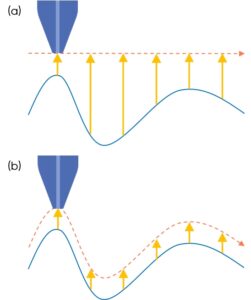
What is Intermittent Contact-Scanning Electrochemical Microscopy?
Intermittent Contact-Scanning Electrochemical Microscopy (ic-SECM) is one of a number of constant distance SECM techniques. In ic-SECM, the probe is vertically vibrated to tap across the sample surface, following its topography throughout the measurement. This removes the influence of topography on the electrochemical response, which only depends on the sample activity. The ic-SECM technique was demonstrated by McKelvey et al. in 2010 [1] and introduced on a commercial instrument exclusively by BioLogic in 2013. This article assumes knowledge of both the dc-SECM and ac-SECM techniques, for more information on these see the SECM101 and ac-SECM101 Learning Center articles. Information on other SECM types can also be found in a further Learning Center article explaining the different SECM types.
What is the difference between constant height and constant distance Scanning Electrochemical Microscopy?
In many scanning probe microscopy measurements, there are two options regarding how the probe behaves in z: (1) The probe can maintain the same z position throughout the measurement, meaning that changes in sample topography result in changes to the probe to sample distance, Fig. 1a. This is referred to as a constant height measurement. (2) The probe changes its z position throughout the measurement following the sample topography to maintain a constant probe to sample distance throughout, Fig. 1b. This is a constant distance measurement. In SECM, and other scanning probe microscopies for which the probe to sample distance can affect the signal of interest it can be advantageous to use a constant distance measurement to avoid the influence of topography on the resulting signal.

Figure 1 : In constant height measurements
(a) the probe to sample distance (shown by the lengths of the yellow arrows)
changes, while the probe position (shown by the dashed red line) remains constant throughout. In constant distance measurements
(b) the probe to sample distance (shown by the lengths of the yellow arrows) remains constant throughout, while the probe position (shown by the dashed red line) changes.
Learn More?
Please click on ‘Request Application Note’ and we will send you the full application note ‘ic-SECM101: An Introduction to Intermittent Contact-Scanning Electrochemical Microscopy’.
